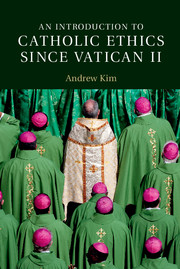Book contents
- Frontmatter
- Dedication
- Epigraph
- Contents
- Foreword
- Preface
- Acknowledgments
- Abbreviations
- Introduction
- PART 1 FOUNDATIONS OF CATHOLIC ETHICS
- 1 Moral Relativism
- 2 The Natural Law and Revelation
- 3 The River Between: Test Case
- PART II GRACE AT THE HEART OF VIRTUE
- PART III CATHOLIC SOCIAL TEACHING
- PART IV BIOETHICS
- Epilogue
- Appendix
- Bibliography
- Index
3 - The River Between: Test Case
from PART 1 - FOUNDATIONS OF CATHOLIC ETHICS
Published online by Cambridge University Press: 05 May 2015
- Frontmatter
- Dedication
- Epigraph
- Contents
- Foreword
- Preface
- Acknowledgments
- Abbreviations
- Introduction
- PART 1 FOUNDATIONS OF CATHOLIC ETHICS
- 1 Moral Relativism
- 2 The Natural Law and Revelation
- 3 The River Between: Test Case
- PART II GRACE AT THE HEART OF VIRTUE
- PART III CATHOLIC SOCIAL TEACHING
- PART IV BIOETHICS
- Epilogue
- Appendix
- Bibliography
- Index
Summary
The social order requires constant improvement: it must be founded in truth, built in justice, and enlivened by love.
Gaudium et spes no. 26It is one thing to consider moral theories in the abstract and quite another to analyze and assess them in relation to concrete practices. In this chapter, therefore, we investigate the moral theories heretofore assessed through an examination of a specific moral issue. Female genital cutting, or circumcision, is still a common practice in several parts of the world. Humanitarian critics of the practice describe it as female genital mutilation, or FGM, because the procedure involves removing a portion or all of the external female genitalia and is normally performed on young girls as a rite of passage into womanhood. The purpose of this chapter is to test the theories we have learned up to now in the light of this controversial practice.
This chapter unfolds in five sections. First, we explore themes found in Ngũgĩ wa Thiong'o's insightful novel, The River Between. Second, we investigate whether the various versions of moral relativism are helpful with respect to arriving at moral judgments regarding both female circumcision itself as well as the Western response to it. Next, we consider the natural law argument to be made against female circumcision. A fourth section shows how norms derived by the natural law elevated sound solution for the issues raised by the practice of female circumcision. We see how this is actually taking place in modern day Kenya. Finally, a summary section addresses a few misunderstandings that may arise with respect to the fundamental claims of the current chapter and the whole of Part I.
THE RIVER BETWEEN
Ngũgĩ Thiong'o is a Kenyan writer whose famous novel, The River Between, first published in 1965, offers a vivid depiction of colonialism's impact on East Africa.
- Type
- Chapter
- Information
- An Introduction to Catholic Ethics since Vatican II , pp. 46 - 58Publisher: Cambridge University PressPrint publication year: 2015



